Books in Development
The Women’s Yellow Pages®
Press photo, 1978
I co-founded a 501(c)(3) non-profit in 1971 to develop media in support of women’s expanding roles in society and to foster community involvement and action. The Women's Yellow Pages® Sourcebook series, with an estimated readership of 200,000, was the first trade paperback to address the women’s self-help market and encouraged women’s groups nationally to develop regional directories. I was the executive editor and art director for five editions published from 1971–1978.
We raised more than a million dollars (adjusted for inflation) from New England foundations, trusts, and corporations, including Aetna Casualty and Life Insurance Company, Boston Herald American, Polaroid Foundation, The Boston Globe, Blanchard Foundation, Cabot Foundation, Digital, First National Bank of Boston, Gillette, IBM, New England Merchants Bank, New England Telephone, Prudential Insurance, Putnam Fund, Shawmut Banks, and Vingo Trust.
Publicity included positive reviews by NPR's "All Things Considered," The New York Times Book Review, McCall's, Redbook, Money Magazine, The Christian Science Monitor, and Library Journal.
Marital Fracture
I was accepted into an interdisciplinary PhD program at MIT in 1982, where I was awarded a Hugh Hampton Young Fellowship for three years to combine studies of mass media, social change theory, and anthropology. My dissertation was titled "Interpreting the Female Voice in Divorce." Building on my photography portfolio of relationships, I began filming a couple going through divorce mediation. I also interviewed prominent experts who analyzed the footage and interpreted the breakdown of communication and the imbalance of power in this couple’s relationship; these included best-selling author and feminist psychologist Carol Gilligan, mediator and MIT professor Michael Wheeler, and New York divorce attorney Sanford Dranoff. I created a demonstration project at the MIT Media Lab called "Marital Fracture" based on this material, showing how the emerging technology of electronic books and interactive video could be applied to create an educational resource for the social sciences, like a high-tech version of The Women's Yellow Pages®.
"Marital Fracture" was featured on videodiscs distributed by MIT. I published academic papers and gave talks and demonstrations at professional conferences and universities around the country, including the National Conference on Family Relations, The American Film Institute, San Francisco Art Institute, and the Association of American Publishers. I received a grant from the Harvard Program on Negotiation to develop a workshop based on "Marital Fracture," and the video case study approach I pioneered became the model for the Harvard Law School's interactive media publishing program.
Learn to See
Starting in 1969 as my thesis project at RISD, I taught instant photography to inner-city schoolchildren in Providence, developing curriculum to encourage self-expression and creativity. In 1974, the Polaroid Foundation published Learn to See, a sourcebook of 101 photography projects by teachers and students edited by photographer Susan Meiselas that included examples from nine of my lessons. I am now developing my own book, Picturing Providence, to showcase the children’s impressive photography and present the lessons that motivated them.
Exploring Childhood
I was hired by Education Development Center in 1972 as the Design Developer of Exploring Childhood, a multimedia high school course to engage students in the study and care of young children. The Office of Child Development saw the course "as a way for students to prepare for parenthood, for careers that involved children, and as citizens responsible for decisions that affect children." I was aware of EDC's revolutionary social science curriculum, Man: A Course of Study, that was delivered to fifth graders as ethnographic films when that was an unconventional method of instruction. I was proud to work with such an innovative organization and felt appreciated for my unique combination of skills as a graphic designer, photographer, teacher, and curriculum developer.
I was tasked with redesigning the experimental course that would eventually be distributed to over 7,000 sites in fifty U.S. states. In addition to personally designing many of the books and art directing the designers on my staff, as a “design developer," I was supposed to collaborate with the curriculum developers rather than simply being a "packager" at the end of the pipeline. My main contribution to the series of eight books and five workshop posters was the introduction of fine art photography to visually communicate content that was equal in value and substance to the text on the pages. At first this was a challenge, because I was working primarily with writers from the Harvard Education School who had little appreciation for the concerns I raised—particularly that teens would find the many pages of dense text an obstacle. I felt vindicated during a site visit to Chinle, Arizona, when the Navajo high school teacher told me that a classroom discussion sparked by the Emmet Gowin image, "Nancy," (a portrait of his niece awaking from a dream while lying on the grass surrounded by her dolls) had been instrumental to engaging her students with the material. In 1973, Exploring Childhood received the Merit Award from the Art Director’s Club of Boston.
Sample pages from these books follow, including How the World Works, Beyond the Front Door, Child’s Play, and Making Connections.
The Fight for Newton Corner
I was the designer and editorial consultant on this book by photographer Jon Chase, which won the Massachusetts Arts Council Award for Design in the Built Environment, 1986.
A Small House to Work In
I wrote this article in Fine Homebuilding magazine (August/September 1982 issue) to encourage women to materialize their dreams. I designed and built a passive solar residence/studio and was the first woman “owner/builder” funded by an FmHA program in Southern Vermont. Reprinted in Fine Homebuilding’s Small Houses book, Taunton Press 1995. Other profiles appeared in New Shelter, Passages, and Savvy magazines.





























